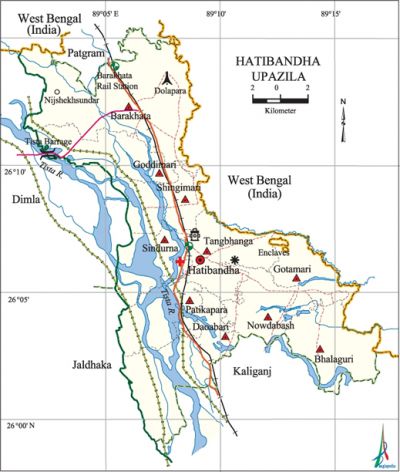Hatibandha Upazila
Hatibandha Upazila (lalmonirhat district) area 288.41 sq km, located in between 25°59' and 26°16' north latitudes and in between 89°01' and 89°17' east longitudes. It is bounded by patgram upazila on the north and west bengal state of India, kaliganj (lalmonirhat) upazila on the south, West Bengal state of India on the east, dimla and jaldhaka upazilas on the west.
Population Total 233927; male 116856, female 117071; Muslim 204244, Hindu 29613, Christian 16 and others 54. Indigenous communities such as santal and garo belong to this upazila.
Water bodies Main river: tista.
Administration Hatibandha Thana was formed in 1914 and it was turned into an upazila' on 15 April 1983.
| Upazila | ||||||||
| Municipality | Union | Mouza | Village | Population | Density (per sq km) | Literacy rate (%) | ||
| Urban | Rural | Urban | Rural | |||||
| - | 12 | 63 | 65 | 9476 | 224451 | 811 | 51.0 | 45.3 |
| Upazila Town | ||||||||
|
Area |
Mouza |
Population |
Density |
Literacy rate | ||||
| 7.29 | 1 | 9476 | 1300 | 51.0 | ||||
| Union | ||||
| Name of union and GO code | Area (acre) | Population | Literacy rate (%) | |
| Male | Female | |||
| Goddimari 38 | 5805 | 8991 | 8992 | 42.9 |
| Gotamari 47 | 5234 | 10648 | 10829 | 44.0 |
| Tangbhanga 95 | 6557 | 14811 | 14522 | 45.7 |
| Daoabari 28 | 9474 | 8933 | 8949 | 35.7 |
| Nowdabash 57 | 4718 | 9240 | 9308 | 45.6 |
| Patikapara 66 | 5575 | 6125 | 6000 | 42.2 |
| Fakir Para 31 | 5407 | 8210 | 8541 | 47.7 |
| Barakhata 15 | 5834 | 11531 | 11612 | 51.2 |
| Bhalaguri 19 | 6686 | 12088 | 12339 | 49.3 |
| Shingimari 76 | 5533 | 11680 | 11466 | 49.5 |
| Sindurna 85 | 5109 | 6645 | 6560 | 48.2 |
| Saniajan 74 | 5338 | 7954 | 7953 | 35.5 |
Source Bangladesh Population Census 2011, Bangladesh Bureau of Statistics.

Archaeological heritage and relics Five domed mosque like house (eighteenth century).
War of Liberation On 9 March 1971, the flag of Bangladesh (with the map of Bangladesh), was hoisted in a gathering at the premises of the Hatibandha Dakbangalow. On 8 April the Pak army took control over Hatibandha; the same day they captured a number of people and brutally killed them at a place adjacent to the Barakhata Bus Stand. On 19 November the freedom fighters raided Barakhata. Pakistani soldiers were forced to surrender in the face of heavy attacks of the freedom fighters on 28 and 29 November. Hatibandha was liberated on 30 November. There are 5 mass graves in the upazila; 4 martyr memorials have been built.
For details: see হাতীবান্ধা উপজেলা, বাংলাদেশ মুক্তিযুদ্ধ জ্ঞানকোষ (Encyclopedia of Bangladesh War of Liberation), বাংলাদেশ এশিয়াটিক সোসাইটি, ঢাকা ২০২০, খণ্ড ১০।
Religious institutions Mosque 343, temple 57, church 2, sacred place 1, tomb 2. Noted religious institutions: Tomb of Garibullah Shah.
Literacy rate and educational institutions Average literacy 45.3%; male 48.2%, female 42.4%. Educational institutions: college 4, secondary school 36, primary school 110, madrasa 56. Noted educational institutions: Alimuddin Degree College (1970), Hatibandha Mohila College (1995), Barakhata College (1999), Hatibandha S. S High School (1946), Barakhata High School (1952), Goddimari Bilateral High School (1961), Nowdabash K. M. S. C High School (1973), Hatibandha Adarsha High School (1994), Bhabanipur Chhafatia Senior Madrasa (1954), Hatibandha Alim Madrasa (1979).
Cultural organisations Library 24, theatre group 3, cinema hall 4, club 15.
Tourist spots Tista Barrage, Shalban.
Main sources of income Agriculture 78.02%, non-agricultural labourer 2.71%, industry 0.26%, commerce 8.14%, transport and communication 2.50%, service 3.16%, construction 0.62%, religious service 0.18%, rent and remittance 0.10% and others 4.31%.
Main crops Paddy, jute, wheat, tobacco, potato, nut, bay leaf, nipa palm, onion, garlic, vegetables.
Extinct or nearly extinct crops Mustard, kaun, sesame, linseed, sugarcane, arahar, barley, sweet potato.
Main fruits Mango, jackfruit, banana, guava, papaya, elephant apple, coconut, indian jujube, betel nut.
Fisheries, dairies and poultries Fishery 514, dairy 12, poultry 60, hatchery 8.
Communication facilities Roads: pucca 102 km, semi-pucca 2 km, mud road 575 km; railway 18 km; waterway 5 km.
Extinct or nearly extinct traditional transport Palanquin, bullock cart, horse carriage.
Noted manufactories Saw mill, ice factory, bidi factory.
Cottage industries Goldsmith, blacksmith, weaving, bamboo work.
Hats, bazars and fairs Hats and bazars are 13, fairs 10, most noted of which are Hatibandha Hat, Barakhata Hat, Doi Khaor Hat, Parulia Hat, Ketkibari Hat; Kazir Bazar and Nowdabash Baddanath Mela, Shibratri Mela, Dhaolai Mela and Parulia Troadashi Mela.
Main exports Tobacco, bay leaf, nipa palm, onion, garlic, banana, flour.
Access to electricity All the unions of the upazila are under rural electrification net-work. However 11.6% of the dwelling households have access to electricity.
Natural resources Stone and sand composed of high quality silicate and manganese has been discovereed in this upazila.
Sources of drinking water Tube-well 98.5%, tap 0.2% and others 1.3%.
Sanitation 55.6% of dwelling households of the upazila use sanitary latrines and 38.3% of dwelling households use non-sanitary latrines; 6.1% of households do not have latrine facilities.
Health centres Upazila health complex 1, union health centre 2.'
NGO activities Operationally important NGOs are brac, RDRS. [SM Altaf Hossain]
References Bangladesh Population Census 2001 and 2011, Bangladesh Bureau of Statistics; Cultural survey report of Hatibandha Upazila 2007.
